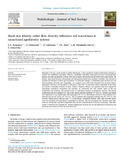| dc.description.abstract | Humanity is facing a rapid decline in global biodiversity, caused mainly by tropical deforestation through industrial and smallholder agriculture. However, smallholder agriculture landscapes host areas containing home gardens and other agroforestry systems (AFS) proved highly relevant for soil and biodiversity conservation. The positive interactions between aboveground and belowground biodiversity probably constitute a key element to promote the efficiency of these agro-ecosystems. To determine whether a relationship exists between tree and soil macrofauna diversity and composition, we compared cacao AFS with contrasted tree diversity along a topography and forest cover gradient in Talamanca, Costa Rica. To determine which components of the shade tree species, community structure (density, richness, Shannon, Pielou), and agroforest floor best explain the macrofauna community composition and structure, we constructed the “best models” based on the tree composition, tree structure, and agroforest floor as explanatory matrices in redundancy analyses. Macrofauna composition was best explained by a mix of tree species and litter attributes (R2=26.5 %), whereas macrofauna and vegetation co-vary significantly with topography (R2=12 %). Macrofauna structure is best explained by a selection of seven tree species (R2=41.2 %). The co-variation with topography remained low (R2=10.9 %). Tree evenness (Pielou index) explained only 7 % of macrofauna community structure while other diversity indices were not correlated with macrofauna composition or structure. The soil macrofauna was therefore more influenced by tree identity and litter composition than by the overall diversity of the tree community. This information is important for designing the optimal combinations of species for the intensification of production and provision of ecosystem services in cacao-based AFS. | |


